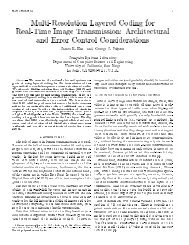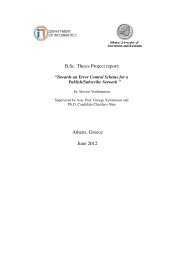In Network Processing and Data Aggregation in
In Network Processing and Data Aggregation in
In Network Processing and Data Aggregation in
Create successful ePaper yourself
Turn your PDF publications into a flip-book with our unique Google optimized e-Paper software.
<strong>In</strong> the data-centric approach we assume that rout<strong>in</strong>g is not optimal. Node A routespacket_A to s<strong>in</strong>k through a longer path (than that used <strong>in</strong> Address centric rout<strong>in</strong>g) withNode D be<strong>in</strong>g the last hop before s<strong>in</strong>k. The data is named (attribute-value form) <strong>and</strong> thenetwork layer protocol can access this <strong>in</strong>formation. It is possible now to perform severalactions depend<strong>in</strong>g on the content the data packets. The most reasonable action that arout<strong>in</strong>g protocol can perform is duplicate suppression. Thus, Node D checks its cache <strong>and</strong>realizes that the packet_A (reached later than packet_B) is identical to packet_B <strong>and</strong> itnever transmits it to s<strong>in</strong>k.Node ANode BNode ANode BNode CNode DNode CNode DS<strong>in</strong>kS<strong>in</strong>kDuplicateSuppressionAddress Centric<strong>Data</strong> CentricFigure 8. Address-Centric Vs <strong>Data</strong>-Centric Rout<strong>in</strong>g2.3.3 Directed Diffusion [3]<strong>In</strong>-network process<strong>in</strong>g must be supported by the network layer mechanism that isused. The implementation of data-centric rout<strong>in</strong>g protocols is ideal for such a purpose. <strong>In</strong>this section we present one of the most common rout<strong>in</strong>g protocols of this category, theDirected Diffusion.Directed diffusion is a data-centric (DC) <strong>and</strong> application-aware paradigm <strong>in</strong> the sensethat all data generated by sensor nodes is named by attribute-value pairs. The ma<strong>in</strong> ideaof the DC paradigm is to comb<strong>in</strong>e the data com<strong>in</strong>g from different sources (<strong>in</strong>-networkaggregation) by elim<strong>in</strong>at<strong>in</strong>g redundancy <strong>and</strong> m<strong>in</strong>imiz<strong>in</strong>g the number of transmissions;thus sav<strong>in</strong>g network energy <strong>and</strong> prolong<strong>in</strong>g its lifetime. Unlike traditional end-to-end








